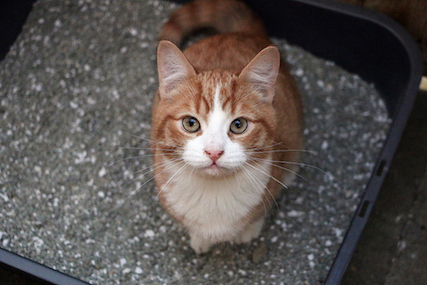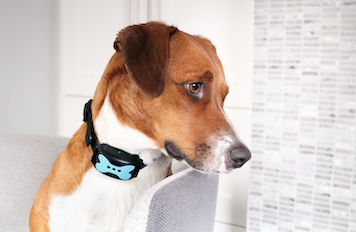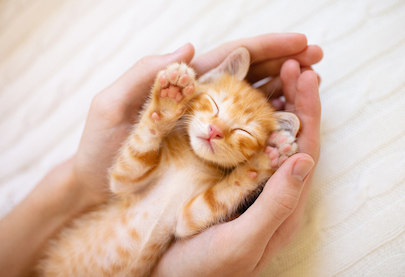
Is your cat not using the litter box? Inappropriate elimination can be an extremely frustrating problem for cat owners. A few accidents turn into your cat regularly missing the litter box. Your house starts smelling a bit unpleasant. You start to wonder why your cat is not using the litter box. Cats stop using the litter box for a few different reasons including undiagnosed medical issues, environmental changes in the home, issues with their specific litter or box, and the location of the litter box.
After analyzing my experiences with hundreds of cat owners, I have put together this guide to litter box troubleshooting. A lot of times, all it takes is some trial and error coupled with a few simple changes to get your cat to eliminate in their litter box once again. First, let’s talk about the most common reasons why cats stop using the litter box. Next, I’ll outline how exactly I recommend you set up your home for success and steps on how to get your cat to start using the litter box again!
Most Common Reasons Your Cat Has Stopped Using the Litter Box
Rule Out Illness
If you notice your cat’s elimination history is out of the ordinary, I recommend that you take them to the vet and check for underlying medical issues. Bring a potty log with you to assist your vet in detecting any irregularities. Request a urinalysis, stool check, and a blood draw. Check for urinary tract infections, kidney disease, thyroid issues, diabetes, or any other age-related issue. If you want to be extra proactive about your cat’s health, I recommend looking into PrettyLitter. PrettyLitter is a color-changing litter making it super easy for you to detect common health issues like UTIs, kidney disease, and more!

Marking Due to Multiple Cats in the Home
Some cats urinate outside of the litter box to mark their territory from other cats. This is especially common with unaltered cats. When cats are marking, they typically tend to urinate on household objects like furniture and curtains. I recommend speaking with your veterinarian about the best time to spay or neuter your cat. This can help with using the litter box and can help prevent other unwanted behaviors as well.
If you have more than one cat in your household, I recommend getting one litter box per cat plus an additional litter box. For example, if you have two cats you should have three litter boxes. If you get a new cat, you shouldn’t change anything about your resident cat’s litter box setup. Put your new cat on a “watch and confine” described in detail below. This method entails choosing a private, easily accessible room for your cat’s litter box and confining your cat in that room at all times while unsupervised. Place two litter boxes in your new cat’s designated confinement room. Once your new cat is reliably using one of the two litter boxes, you can put both cats’ litter boxes in the same room assuming they are getting along well.
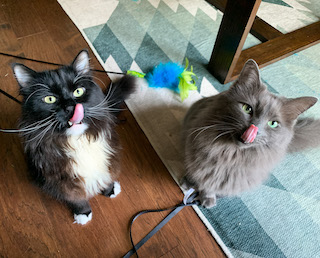
Multiple Accidents in the Same Spot
If access is blocked to your cat’s litter box room, your cat will find somewhere else to go. If this has already happened once, it’s more likely to happen again. Be sure to block off the area where they had the accident. Make sure your cat can access the litter box 24/7. Cat doors can be great to ensure constant litter box access. If your cat had an accident in a small room, make sure the door to that room is always closed. If your cat had an accident in a larger living space that is difficult to block by closing the door, place a spiky chair mat for carpets upside down to block the space.
Startling Event Disrupting Elimination
If something scary happens to your cat like a strange, loud sound from your dryer as they are going potty, they might be scared of using that litter box again. Your cat can also get startled by the noises from an automatic litter box cleaner. You have two options if this happens. You can remove whatever caused the scary noise from the room. Alternatively, you can move your cat’s litter box to a different room where they won’t be bothered by anything startling. If you move the litter box to a new room, go back to the watch and confine method outlined below for 10 days. Block off access to the previous litter box room. If you remove whatever caused the scary noise, do the watch and confine method for a few days and feed your cat’s meals in the designated litter box room to create a positive association and eliminate fear-related behavior.

Indoor Plant Confusion
Sometimes cats confuse the soil in indoor plants as an appropriate place for them to go potty. This is especially common with cats that live both indoors and outdoors. The good news, you don’t have to sacrifice your plants. Simply put tape around the top of the plant’s pot so that your cat cannot access the soil.
The Ideal Litter Box Setup and the Watch and Confine Method
To anyone still struggling with their cat using the litter box, I recommend putting in place what I call the “watch and confine” method. This method of litter box training works for 99% of cats in the housebreaking cases I’ve seen!
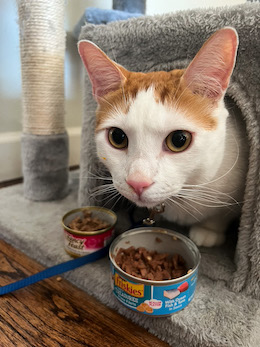
- Choose a confinement room for your cat’s litter box. It should be accessible AT ALL TIMES but somewhere private and low-traffic. Examples include an extra bathroom, basement, closet, or quiet area in the laundry room. If possible, install a cat door in this room to ensure your cat has access to the room at all times. This can also prevent other animals from wandering in. The confinement room should contain pleasant, ideally elevated areas for your cat to rest as well as access to water. It should not contain any throw rugs, absorbent material on the floor, or planters. I also recommend removing any bedding if they have previously targeted bedding as a potty spot.
- Put your cat on what I call a “watch and confine”. Confine them in a room with a litter box whenever they are unsupervised to prevent them from having accidents. If your cat continues to have accidents while confined, choose a smaller designated room. When they are out of confinement, have them wear a brightly colored leash so you can keep a close eye on them to watch if they have an accident or make an attempt to move toward the litter box. The goal is to see exactly where and when your cat is eliminating. Slowly increase freedom and the size of confinement as they stop having accidents.
- Teach your cat where to go potty. Reinforce all pottying in the litter box. Wait until your cat is coming out of their box, and give your cat three of their favorite small treat and lots of praise. It’s super important to give your cat feedback on the behavior you want them to perform. Give your cat a verbal reprimand for inappropriate elimination. If you catch your cat going potty anywhere outside of their litter box, give a firm verbal reprimand, “NO!”. Remember, only do this if you catch your cat in the act or right after they have the accident. If somehow you miss an accident, refrain from giving your cat a verbal reprimand and try again the next time they go potty.
- Block off spots of past accidents. If your cat has eliminated multiple times in the same spot, be sure to block off that spot. If your cat has eliminated in a spot before, they are more likely to revisit that spot. If the spot is in a small room, make sure the door to that room is always closed. If the spot is in a large living space that you can’t easily block off, place a spiky chair mat for carpets upside down to block the space.
- Experiment with different litter and boxes. The height of the litter box should be low enough so that your cat can easily get in and out. This is especially important for older cats that might have limited mobility. You might also see if your cat prefers a covered or flat box. You might even try placing 2-3 different litter boxes side by side in the same room with different litters and letting your cat choose which combination they prefer.
- Clean the litter box every couple of hours. As cleanliness could be the issue as to why your cat is avoiding the litter box, a once-a-day cleaning is probably not going to cut it. Although it will add a little extra time to your daily routine, I recommend cleaning the litter box every time your cat goes potty and checking it every couple of hours. Better to be safe than sorry in this case and cleaning the litter box will be easier than cleaning spots your cat has eliminated outside of it. Take note when there is urine or feces.
- Use a log to keep track of when your cat is eliminating. A log will help you know what to expect in terms of your cat’s potty schedule. It will also help you predict their movements and detect irregularities in their patterns.
- Be patient and celebrate the small wins. If your cat goes 3 days without any accidents, celebrate! If your cat goes 10 days without any accidents, you can expand the area of their designated room and celebrate again! Litter box troubleshooting can be hard but with a little patience and consistency, you will get your cat to start using their litter box again.
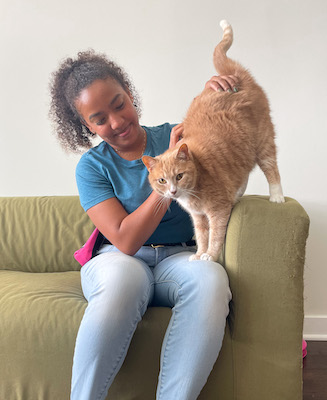
I hope these tips help you put an end to your litter box struggles! If you tried the above and are still experiencing issues, feel free to contact us. We have in-home cat training programs in Austin, Dallas, Houston, and Kansas City! One of our behavior consultants will come to your home, assess your litter box setup, and give you a detailed training plan on how to get your cat to use the litter box again. If you do not live near any of our cities, you can schedule a virtual consultation with one of our trainers for expert advice as well. Happy litter box training!
*This page contains Amazon affiliate links. If you choose to purchase after clicking a link, we may receive a commission at no extra cost to you.*
